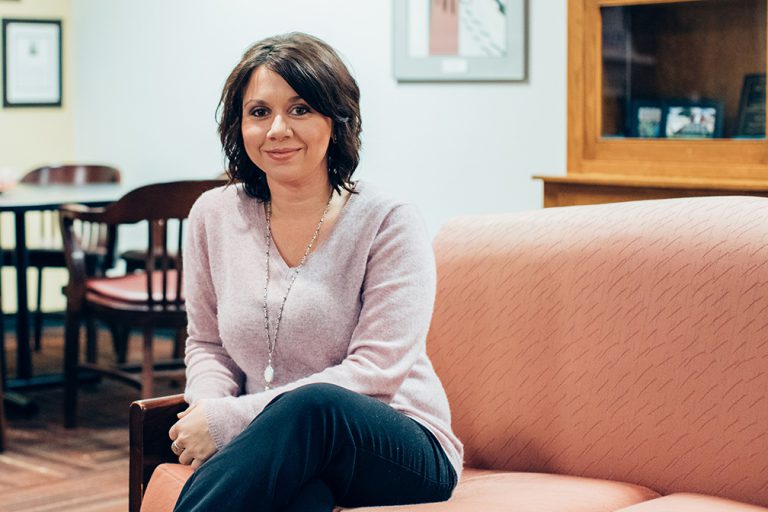American Indian and Indigenous Community Center Flourishes
February 12, 2019

When Melissa Faircloth became director of Virginia Tech’s American Indian and Indigenous Community Center last fall, she brought a wealth of experience, relationships, and dedication to the position.
Faircloth was one of the first programming assistants for the center when it was established in 2016. That experience and her involvement with Native at Virginia Tech, the Native student organization on campus she now formally advises, have informed her approach to shaping the community center.
“I really envision a dynamic center that is able to assist with student transition and growth from the time they arrive at Virginia Tech through graduation and beyond,” Faircloth said. “I also hope to engage more of the broader campus community in both programming and conversations. The goal is to effectively support students within the Indigenous community while simultaneously creating more awareness across campus regarding Indigenous issues.”
As she completes a doctoral degree in sociology at Virginia Tech, Faircloth’s research focuses on the experiences of Native students on college campuses and the role that centers play in that experience. It examines both best practices and challenges within these spaces as they strive to serve Indigenous student populations.
“Building community is important for college students,” Faircloth said. “For most, it is their first time living away from home. It can be very isolating if you struggle to find a community to connect with. Isolation and lack of social support tend to be major reasons that students, especially marginalized students, leave college before obtaining a degree. In a hierarchy of needs, learning is not prioritized until social and emotional needs are met.”
Faircloth added that cultural centers facilitate community-building and social support for many students across campus. “We are able to fulfill that need while also encouraging students to take advantage of other services and resources at Virginia Tech,” she said. “Intentional collaboration with campus partners is another way in which we serve students; connecting them to academic assistance, counseling, health services, and more.”
Faircloth’s appointment as American Indian and Indigenous Community Center director coincides with a university-wide effort to recruit more Native American students. As part of the Virginia Tribal Initiative, Virginia Tech is tapping into the energy and expertise of current and former Native students, who are building connections with Virginia tribes and acting as ambassadors for Virginia Tech.
Virginia Tech’s mission to become more diverse has become integral to its future. President Tim Sands has set an ambitious goal for recruitment of underrepresented and underserved groups, including minorities, first-generation college students, and those from low-income households. The current class of students comprises about 30 percent who are from those groups. Virginia Tech aims to reach 40 percent by 2022.
“Inclusion and diversity are core to our role as an engine for social and economic mobility, for attracting talent from the broadest pools possible, and for ensuring that all of our students have on-campus experiences that prepare them for the world they are about to enter,” Sands said.
Faircloth said the initiative will require strategic planning and collaboration with various groups across campus.
“We are thinking about the entire student trajectory and what services or programs can facilitate a positive experience for them,” she said, adding that she is seeking input from students and establishing an evaluation process to assess the success of the community center’s programming and events. She also intends to track student needs that arise over the semester and how well the center is addressing those needs or directing students to appropriate resources on campus.
“Students seem to have more and more demands placed on them with each passing year,” Faircloth said. “College can be stressful. Many students are juggling academics and one or more part-time jobs. Students often load themselves down with extracurricular and leadership activities in order to be competitive both in the job market and for scholarship programs. With everything they have going on, I am always impressed by their interest in creating new initiatives on campus and their dedication and capacity to be change-makers.”
“As the first director to lead the American Indian and Indigenous Community Center, Melissa will provide a vision and infrastructure that supports student success and community enrichment,” said Yolanda Avent, director of Cultural and Community Centers. “We are so excited to have her on board and look forward to increasing collaboration across the university with our American Indian and Indigenous Community Center.”
Faircloth is originally from eastern North Carolina. She received a bachelor’s degree in business and a master’s degree in sociology from East Carolina University and worked in academic advising for the university.
Faircloth was recognized as 2017 Graduate School Diversity Scholar at Virginia Tech for initiating and planning Virginia Tech’s first Inter-tribal campus powwow, increasing cultural education and the visibility of Indigenous students. She presented “Place Making, Community Building, and Resistance: An Ethnographic Case Study of American Indian Centers” at the 30th Annual Undergraduate and Graduate Student Research Symposium at Virginia Tech. In 2018, she presented “Building Space for American Indians in Higher Education” at the 12th Annual American Indian Women of Proud Nations Conference.
As director of the American Indian and Indigenous Community Center, Faircloth advises the Native at Virginia Tech student organization, collaborates with the American Indian and Indigenous Faculty/Staff Alliance, and coordinates American Indian Heritage Month events.
Written by Sandy Broughton and photographed by Christina Franusich







